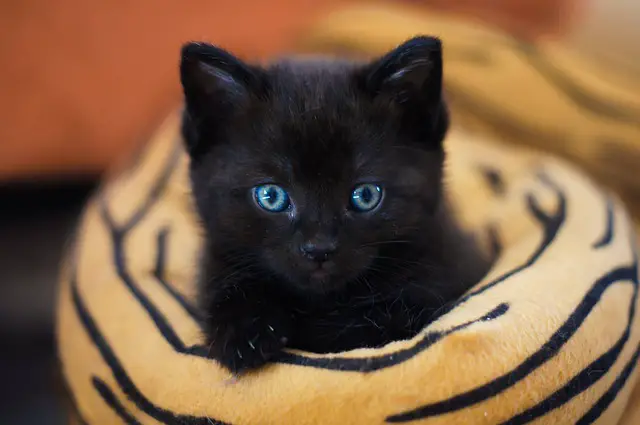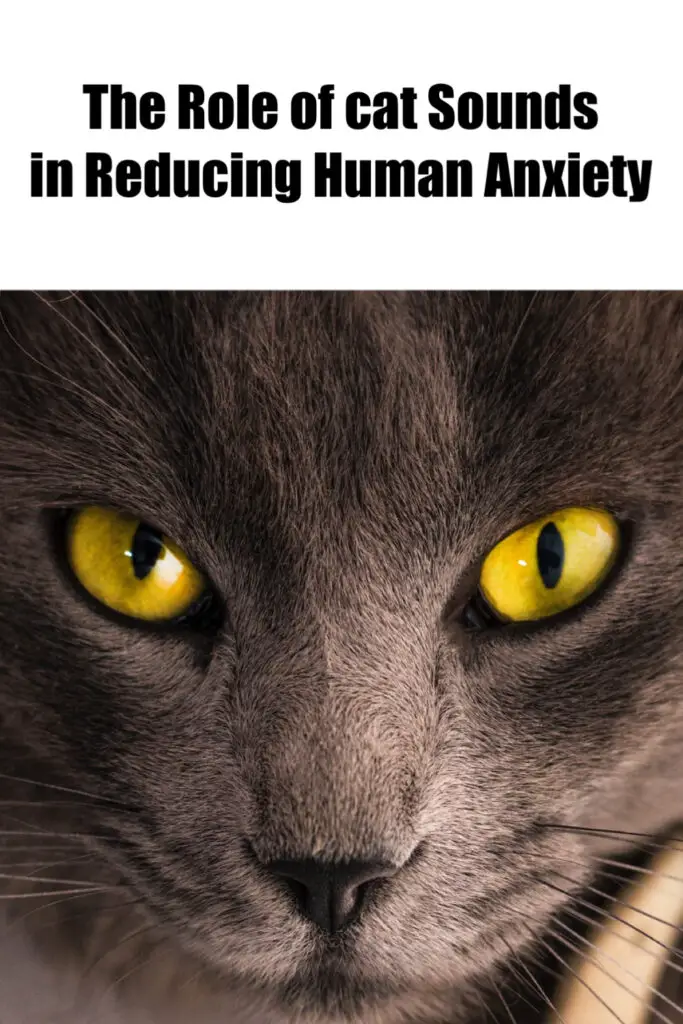
Do you ever feel stressed out? If so, you may be able to reduce your anxiety and relax by listening to the purrs of cats.
Cat purring is a sound that has been used for centuries as a way to promote calmness and relaxation in humans.
In this article, we will discuss the frequency and duration of these purrs, explore their effects on human psychology, investigate the science behind them, examine possible causes for them, and look at our bond with cats.
So if you’re feeling anxious or overwhelmed, grab your feline friend and enjoy some calming cat sounds!
Frequency and Duration of Purrs
Although purrs vary in freq. & duration, they still provide a calming effect on people. Listening to purrs can be beneficial for humans, as the sound of a cat’s purr has been found to have a frequency range between 20-140 Hz, which is known to reduce stress and anxiety levels. The intensity of the purring also plays an important role in its effectiveness.
Studies have shown that cats tend to increase their purring when they are around humans, suggesting that cats may be aware of how their sounds affect us. The effects of these low-frequency vibrations on human psychology are quite remarkable; research has demonstrated that listening to cat purrs can lower blood pressure and heart rate, while also reducing feelings of loneliness and depression. Additionally, it has been suggested that the vibrations from a cat’s purr may even help with healing wounds or bone fractures due to its ability to stimulate tissue regeneration.
Not only do cats use their purring as a way to communicate with us, but it appears that we can use it as well! Studies have shown that petting cats while listening to their purrs can lead to increased levels of oxytocin (the “love hormone”) in both humans and cats alike. This suggests that not only does our presence comfort them, but theirs comforts us too!
These findings demonstrate just how powerful the bond between humans and cats really is – one based on mutual understanding and trust. As such, it is no surprise that spending time with our feline friends can bring about so many positive psychological benefits for both species.
Moving forward into the next section about the ‘effects of purring on human psychology’, we will explore this connection further.
Effects of Purring on Human Psychology
Through its calming vibrations, the feline’s vocalizations can have a profound impact on our mental health. Purring has been observed to reduce stress and anxiety levels in humans, with some studies attributing this effect to the frequency of purrs. One study found that when pet owners listened to recordings of cats purring for 10 minutes, it produced meditative effects similar to those associated with human-led meditation sessions.
Further research into the psychological effects of pet ownership also indicates that owning a cat may help reduce stress and anxiety levels in humans due to the bond created between owner and pet. In addition, simply stroking a cat’s fur can be therapeutic; it releases oxytocin which further reduces feelings of anxiety or fear.
The findings suggest that purring can provide more than just companionship; it has potential therapeutic benefits too. While scientific evidence on this subject is limited, there is ample anecdotal evidence from pet owners who report having lower stress levels when they are around their cats. Research shows that these effects are not solely due to domestication as wild cats still exhibit similar behaviors towards humans when kept in captivity.
This suggests that purring may be an ancient form of communication designed by animals to soothe their human counterparts. Moving forward, further research into this phenomenon will help us understand how we can use cat sounds as a form of alternative therapy for reducing human anxiety and other emotional issues such as depression or PTSD.
With new technology such as sound baths becoming increasingly popular among wellness professionals, incorporating cat sounds into more mainstream therapies could open up possibilities for improving mental well-being without medication or invasive treatments. As investigations continue, we may soon discover an evolutionary link between cats and humans that goes beyond mere companionship – one where both species benefit mutually from one another’s presence and support each other through difficult times.
This research provides us with insight into the potential power of felines’ vocalizations on our mental health – something worth exploring further if we want to find new ways to reduce stress levels in today’s world.
The Science Behind Cat Purring
Feeling the purr of a cat in our lives can have a profound impact on our mental well-being, and science is beginning to uncover the mysterious power behind it.
Studies have shown that when cats vocalize, they tend to produce a low-frequency rumble known as purring. This unique sound has been found to occur at frequencies between 25 and 150 hertz, with an average volume of about 60 decibels – similar to the volume of human conversation.
The length and intensity of these purrs vary depending on context; cats typically make louder noises when they’re content or seeking attention from their owners.
Interestingly, humans may be able to detect subtle differences between these various types of cat vocalizations. For example, some studies have suggested that we are better able to distinguish between friendly meows versus angry hisses than we are able to differentiate among different breeds of dogs.
This could be because cats’ purrs contain more complex harmonic structures than other animal sounds – providing us with yet another indication that there is something special about cat vocalizations.
The physical effects of this unique sound may also contribute to its calming qualities for humans: Researchers have discovered that exposing people to recordings of cat purrs can reduce heart rate and lower blood pressure levels in those experiencing anxiety or stress.
Additionally, scientists believe that exposure to this frequency range may even promote healing by stimulating bone growth and muscle repair in both cats and people alike – creating an even deeper connection between the two species!
All this evidence points towards one indisputable fact: cat purring has a powerful effect on us both emotionally and physically. We still don’t fully understand why or how it works – but its soothing quality is undeniable.
So next time you hear your beloved pet’s contented rumbling, take a moment to appreciate how much joy they bring into your life – you might just find yourself feeling calmer too!
Possible Causes of Purring
You may be curious about the causes of purring, so let’s explore what science has uncovered. It turns out that cat genetics play a role in their ability to purr. Cats are able to produce this sound because they have a unique laryngeal and diaphragmatic anatomy which allows them to vibrate their vocal cords at a frequency of 25-150 Hertz. This vibration is then amplified by the cat’s chest cavity, producing the familiar purring sound.
Not only do cats enjoy making this noise, but it also provides them with numerous benefits. Purring helps cats heal from injuries or illnesses faster due to its low-frequency vibrations which can stimulate bone growth and repair muscles and tendons. Additionally, cats use purring as a way to communicate with other cats and humans alike – it can be used as an expression of contentment or even as a plea for help!
It’s clear that there are many advantages for cats when they purr, but what about us? Studies have shown that listening to cat sounds can reduce stress levels in humans by up to 40%. This could be due to the fact that hearing these noises triggers our brains’ reward centers, releasing endorphins which make us feel relaxed and happy.
Furthermore, spending time with our feline friends has been linked with improved mental health outcomes such as reduced anxiety and depression symptoms. The connection between humans and cats goes beyond just physical contact; we share an emotional bond too! Our relationship with felines is one of mutual understanding – we both benefit from each other’s presence in ways that go beyond words.
As we continue on this journey together exploring our bond with cats, let’s remember how much joy they bring into our lives through their comforting purrs!
Our Bond with Cats
Cuddling up with your furry friend can bring a deep sense of connection and understanding, allowing both you and your cat to feel at ease. This connection is further strengthened by the variety of sounds cats make, including purring.
Our bond with cats has been studied for centuries, as their personalities have allowed us to form an emotional connection between ourselves and our feline friends. Petting has also been known to reduce stress and anxiety in humans, likely due to the release of oxytocin which is triggered by physical contact. In addition, studies have found that petting cats actually increases a cat’s purr frequency and length.
This combination of physical touch and sound is likely why so many people find comfort in cats, as these behaviors create an atmosphere of warmth and safety that can be calming even in difficult times. Cats also have their own unique way of expressing themselves through vocalizations like purring; this allows us to interpret our cat’s feelings—like contentment or excitement—and open up communication between us both.
It’s no wonder then that we develop such strong bonds with our furry friends over time as we learn how best to communicate with each other! The relationship between humans and cats has become increasingly important over the years as people are more often turning towards animals for companionship in times of stress or loneliness.
The psychological benefits related to owning a pet are vast; they provide us with unconditional love and comfort while helping alleviate some mental health issues like depression or anxiety. Cats especially serve as wonderful companions because they’re low-maintenance, affectionate creatures who often show their appreciation through purrs when we give them attention or cuddle them close on cold nights.
Not only do their gentle meows help us relax but also their presence alone acts as a reminder that we’re not alone during tough times – this simple gesture can mean so much more than words ever could!
It’s clear then that the relationship between humans and cats goes far beyond just petting: it’s about creating an environment where both parties feel safe enough to interact without judgment or fear—an essential element for any healthy relationship! Whether it’s through snuggling together on the couch or responding positively when our kitty makes those adorable little noises, there’s something special about having a feline friend around that brings out the best in us all.
Final Thoughts
You can’t deny the power of a purr. Not only do cats use purring to communicate with us, but it can also have a positive effect on our mental health.
The soothing sound of their purrs can reduce stress and anxiety levels, leaving us feeling more relaxed and connected to our furry friends.
Next time your cat starts to purr, take a moment to relax and be thankful for the calming presence they bring into your life. You won’t regret it!

Lee Harris
Latest posts by Lee Harris (see all)
- Homemade Cat Cookies: A Purr-fect Treat for Any Occasion - February 7, 2024
- Chic Feline Elegance: Crafting a Multi-Tiered Black Cat Cake - February 6, 2024
- Purr-fectly Delicious: Black Cat-Themed Donut Delight - February 5, 2024


